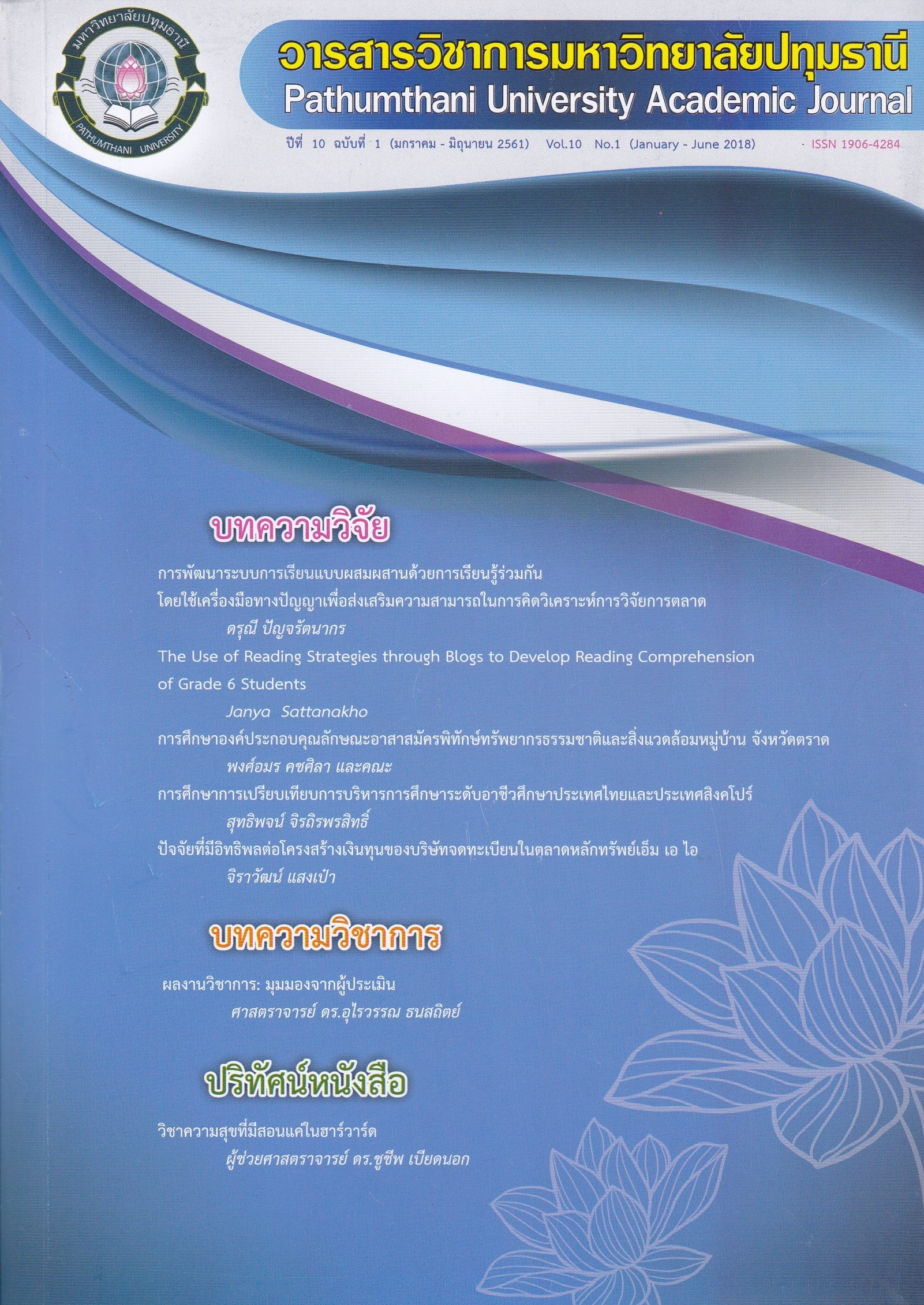The Visualization ability of Three Dimensional Geometric cross-sections Of The Elementary Students
Keywords:
การนึกภาพทางคณิตศาสตร์, การสอนคณิตศาสตร์Abstract
The purpose of this research was to study the visualization ability of threedimensional geometric cross-sections of the elementary students. 6 Mahasarakham Main School Amphoe Mueang Maha Sarakham Mahasarakham province In the second semester of academic year 2016, 171 students were randomly assigned to stratify by proportion. Then grade the score by making a mathematical model of student's imagination into 3 groups: high score Moderate score And low score groups By simple random sampling, each group comprised of 9 students (case study) to study the concept of cross-sectional geometry. The instruments used in the study were 16 students' mathematical imagination ability test. Mathematical Imagination Education The visualization of the cross-sections of three-dimensional geometry of Prathomsuksa 6 students showed that the students had a horizontal planar cut of three-dimensional geometry. Accounted for 30.92 percent. Straight cuts of three-dimensional geometry Percentage 27. Any part of the three-dimensional geometry 21.29 percent and diagonal cut of three-dimensional geometry. 20.35 percent. And in this study, we can see that. Students with mathematical imagination. It can be visualized in the brain or ideally by using the cutting experience. Can be seen in the cut along the lines of three-dimensional geometry. Can accurately describe the cross-section. And it can draw out correctly because students use the classroom experience. Bring shapes relative to surrounding objects. And link classroom and real-life experiences to help with mathematical imagination.
References
2. อัมพร ม้าคนอง. (2554). ทักษะและกระบวนการทางคณิตศาสตร์. กรุงเทพฯ: จุฬาลงกรณ์ มหาวิทยาลัย.
3. Arcavi, A. (2003). “The role of visual representations in the learning of mathematics”. Educational Studies in Mathematics. Proceedings of the 18th International Conference on the Psychology of Mathematics (PME 18). 2: 130- 127.
4. Arnheim. (1991). “Perception cognition and visualization”. Journal of Biocommunication. 18(2): 2 -5.
5. Duval. (1998). “Geometry from a cognitive point a view. Perspectives on thr Taching of Geometry for the 21st Century” Kluwer Academic Publishers Dorecht. 2(1): 142 – 157.
6. Edwerd J.Davis. (1973). “A study of the ability of selected school pupils to perceive the plane sections of selected solid figures”. Journal For ReSearch in Mathematics Education. 4(3): 132 – 140.
7. Fennema & Tartre. (1985). “The use of spatial visualization in mathematics by girls and boys”. Journal for Research in Mathematics Education. 16(3) : 184 – 206.
8. Guzmán, M. (2002). The role of visualization: In teaching and learning of mathematical analysis. Paper presented at the 2nd International Conference on the Teaching of Mathematics.
9. Hasan, U. (2004). “High and Low Visualization skills and Pedagogical Decision of Preservice Secondary Mathematics Teacher”. Education. 131(3): 471-480.
10. Jill Everett & Joanne Mulligan. (2000). Students’ Visualisations of Threedimensional Shapes. MERGA23 : Macquarie University. Owen. (1994). How Liberalism Produces Democratic Peace. International Security. N. J.: Prentice-Hall Inc.
11. Zazkis, R., Dubinsky, E., Dautermann, J. (1996). “Coordinating visual and analytic strategies: A study of students’ understanding of the group D4”. Journal for Research in Mathematics Education . 27(4): 435 – 457.
Published
How to Cite
Issue
Section
License
บทความที่ได้รับการตีพิมพ์เป็นลิขสิทธิ์ของวารสารมหาวิทยาลัยปทุมธานี
ข้อความที่ปรากฎในบทความแต่ละเรื่อง เป็นความคิดเห็นส่วนตัวของผู้เขียน กองบรรณาธิการไม่จำเป็นต้องเห็นด้วยเสมอไป และไม่มีส่วนรับผิดชอบใด ๆ ถือเป็นความรับผิดชอบของผู้เขียนแต่เพียงผู้เดียว



